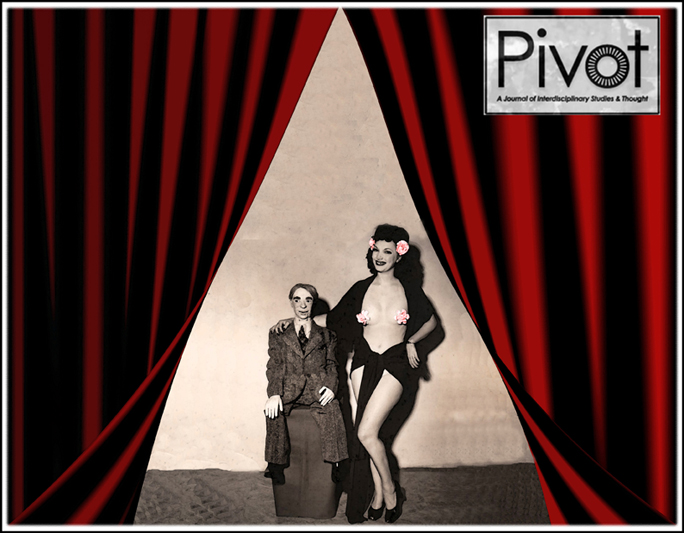She’s Such a Tease: The Feminine as Burlesque Performance in Margaret Atwood’s _The Edible Woman_
DOI:
https://doi.org/10.25071/2369-7326.34736Abstract
This paper proposes that the dominant imageof Margaret Atwood's The Edible Woman is that of the female as prey or commodity, and that this image can also be understood as the female as burlesque performer. As her marriage looms, Marian negotiates a complex set of social instructions on how to present herself as the ideal woman. This desired image involves strategic teasing and revealing for a male spectator: Marian’s appearance, as well as her behaviour, should be calculated to satisfy, but not sate, her male audience’s appetites. Lucy, Marian’s colleague, and Ainsley, Marian’s roommate, perform their own versions of femininity within what Judith Butler has since identified as “the obligatory frame of reproductive heterosexuality.” The cake that Marian bakes in her own image, and then consumes, demonstrates her rejection of this compulsory, commodified bawdy role. However, she searches in vain for an alternative definition of femininity—one that did not yet exist when the novel was written in the early 1960s.References
Allen, Robert C. Horrible Prettiness: Burlesque and American Culture. Chapel Hill: U of North Carolina P, 1991. Print.
Atwood, Margaret. The Edible Woman. Toronto: Seal-McClelland and Stewart, 1978. Print.
Boynton, Victoria. “The Sex-cited Body in Margaret Atwood.” Studies in Canadian Literature/Études en littérature canadienne 27.2 (2002): 51-70. Print.
Butler, Judith. Gender Trouble: Feminism and the Subversion of Identity. New York: Routledge, 1999. Print.
Genette, Gérard. Palimpsests: Literature in the Second Degree. Trans. Channa Newman and Claude Doubinsky. Lincoln: U of Nebraska P, 1997. Print.
Goldblatt, Patricia F. “Reconstructing Margaret Atwood’s Protagonists.” World Literature Today 73.2 (1999): 275-82. Proquest Direct Complete. Web. 16 Jan. 2012.
Greene, Gayle. Changing the Story: Feminist Fiction and the Tradition. Bloomington: Indiana UP, 1991. Print.
Hobgood, Jennifer. “Anti-Edibles: Capitalism and Schizophrenia in Margaret Atwood’s The Edible Woman.” Style 36.1 (2002): 146-68. Proquest Direct Complete. Web. 16 Jan. 2012.
Jehlen, Myra. “Gender.” Critical Terms for Literary Study. Ed. Frank Lentricchia and Thomas McLaughlin. 2nd ed. Chicago: U of Chicago P, 1995: 263-73. Print.
Kelly, Darlene. “‘Either Way, I Stand Condemned’: A Woman’s Place in Margaret Atwood's The Edible Woman and Margaret Drabble's The Waterfall.” English Studies in Canada 21.3 (1995): 320-32. DOI: https://doi.org/10.1353/esc.1995.0024
Melley, Timothy. “‘Stalked by Love’: Female Paranoia and the Stalker Novel.” Differences: A Journal of Feminist Cultural Studies 8.2 (1996): n.p. Academic OneFile. Web. 16 Jan. 2012.
Nally, Claire. “Grrrly Hurly Burly: Neo-Burlesque and the Performance of Gender.” Textual Practice 23.4 (2009): 621-43. Routledge. Web. 23 Nov. 2012.
Peel, Ellen. “Subject, Object, and the Alternation of First- and Third-Person Narration in Novels by Alther, Atwood, and Drabble: Toward a Theory of Feminist Aesthetics.” Critique 30.2 (1989): 107-22. Periodicals Archive Online. Web. 16 Jan. 2012.
Sally, Lynn. “‘It is the Ugly that is So Beautiful’: Performing the Monster/Beauty Continuum in American Neo-Burlesque.” Journal of American Drama and Theatre 21. (2009): 5-23. Proquest Direct Complete. Web. 23 Nov. 2012.
Saussure, Ferdinand de. Course in General Linguistics. Ed. Perry Meisel and Haun Saussy. Trans. Wade Baskin. New York: Columbia UP, 2011. Print.
Tolan, Fiona. Margaret Atwood: Feminism and Fiction. Amsterdam; NY: Rodopi, 2007. Print. DOI: https://doi.org/10.1163/9789401204545


